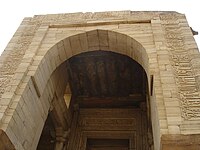| Sultan Ghari | |
|---|---|
 Tomb of Prince Nasiru'd-Din Mahmud | |
| Basic information | |
| Location | |
| Geographic coordinates | 28°35′28.7″N 77°14′30.5″E / 28.591306°N 77.241806°ECoordinates: 28°35′28.7″N 77°14′30.5″E / 28.591306°N 77.241806°E |
| Affiliation | Islam |
| Province | Delhi |
| Territory | Delhi |
| Year consecrated | 1231 A.D |
| Ecclesiastical status | Tomb |
| Leadership | Iltumish of the Slave Dynasty |
| Architectural description | |
| Architectural type | Fortress |
| Architectural style | Persian and Oriental |
| Year completed | 1231 A.D |
| Specifications | |
| Materials | Grey Sandstone & Marble |
Sultan Ghari was the first Islamic Mausoleum (tomb) built in 1231 AD for Prince Nasiru'd-Din Mahmud, eldest son of Iltumish, in the “funerary landscape of Delhi” in the Malakapur village( nearVasant Kunj). Iltumish was the first Sultan of the Slave Dynasty who ruled in Delhi from 1210 to 1236 A.D. The area where the Ghari (meaning: cave) tomb is situated, was part of the first city of medieval Delhi known as the Slave Dynasty that ruled during the period 1206 to 1290.This area is now part of the Qutb complex. The Slave Dynasty was the forerunner under the early Delhi Sultanate (دلی سلطنت) that ruled from 1216 to 1516. This dynastic city was followed by creation of other five cities of Delhi ruled by different dynastic rulers of the Delhi Sultanate, namely, the Khilji dynasty (1290-1320), the Tughlaq dynasty (1320-1413), the Sayyid dynasty (1414-51), and the Lodi dynasty (1451-1526). The rule of the Mughal Empire then followed and lasted from 1526 to 1857.
The crypt or the tomb is implanted in a Ghari (cave), approached by winding steep stairs made of stone, and supported by pillars and flooring. The cave is covered by an unusual octagonal roof slab. The exterior of the tomb structure built in Delhi sandstone with marble adornment exhibits a walled area with bastions (towers) on corners, which impart it the look of a fortress in aesthetic Persian and Oriental architecture. The other tombs inside the Ghari have not been identifiedHistory
Iltumish, ruling from Delhi since 1210 A.D., invaded eastern India in 1225 A.D. to capture Laknauti (now a ruined city in West Bengal called Gaur). The resultant battle ended in signing of a Treaty between Izaz, the then ruler of Eastern India (Bihar and Bengal) and Iltumish; the former ruler agreeing to pay a surety of 80 lakh tankas (silver currency), 38 elephants, mint and issue of coins in the name of Iltumish and accepting Sultan’s suzerainty over the region. Before returning to Delhi, Iltumish divided the region into Bihar and Lakhnauti, and installed Alauddin masud jani as his feudatory in Lakhnauti. But Jani’s control was short lived as he was overthrown by Iwaz soon after Iltumish’s departure.
There after, Iltutmish deputed his eldest son prince Nasiru'd-Din Mahmud to fight Iwaz. In the battle which took place near Lakhnauti, Iwaz was trounced and executed in 1227 A.D., along with his nobles. Prince Nasiru'd-Din Mahmud who was then appointed as governor of Lakhnauti province, merged his original province of Oudh with Bengal and Bihar, and established his capital at Lakhnauti. This act of his coupled with the fact that he was son of Iltumish enhanced his prestige in the province. As a reward, he was given the honorific title of ‘Malik-us-Sharq' (king of the East) by Iltutmish. His rule was short lived, eventful and he could consolidate his territory.[8] But after a short rule of 18 months, Nasiru'd-Din Mahmud was killed. Immensely grieved by the death of his favourite eldest son, Iltumish built a tomb called the Sultan Ghari in memory of his son, in 1231 A.D., close to the Qutb complex. Five years later, Iltumish died in the year 1236 and his tomb can be seen in the Qutb complex. His two other sons, namely Ruknuddin Feroze Shah (died 1237 A.D., after he was deposed) and Muizzudin Bahram Shah (was killed in 1241 A.D.) who ruled for short periods, before and after their famous sister Razia Sultan ruled Delhi, were also buried in separate Chhatris (cenotaphs), just next to the Sultan Ghari. One of the two Chhatris (pictured) is restored while the other has been destroyed. Some archelogical findings reported by the Archeological Survey of India are a) the inscription of 1361 recording the excavation of a tank on the occasion of a marriage, b) a stone linga (phallic symbol of Lord Shiva the Hindu God in a lintel and c) a dilapitated mosque of Sultan Feroz Shah Tughlaq's time and a few scattered remnanats of the Moghul period.
Structure
The plan of the tomb structure is unusual. It is in the form of a fortress with a courtyard like layout, not common among tombs. It is built over a raised plinth of certain height in rubble masonry work. The octagonal shape of the tomb is also unique as it has been built within the fortress like outer structure with four corner towers, over a Ghari (cave) in front of the western Qibla wall of the mosque. It, thus, is a combination of an over ground tomb with towers (which is common in most of the tombs) and an underground chamber for the crypt.
The octagonal grave–chamber with the crypt (tomb) in an underground opening is supported on four columns raised with two pillars each that support beams, and depict ancient Indian temple relics both on the columns and on the floor. The roof of the chamber is built in thick lime–concrete. The western qibla (prayer wall) which has the mihrab, is made of marble in exquisite Turkish and Afghan design. The marble mihrab also has inscriptions from the Quran. The front elevation of this west wall has a marble facade, dated to Feroze Shah's rule (1351-88). The prayer chamber in front of the qibla depicts a yoni-patta (the base slab of a Linga
The entire tomb depicts a trabeate or corbel arch construction, which was common in India before the true arch design of the Romans was introduced, which are seen in subsequent Islamic monuments. Feroz Shah Tughlaq (1351–1388 A.D.) is credited to have repaired the tomb, which had been substantially damaged. The Chhatri, a stand alone structure, next to the Sultan Garhi, a tomb of one of the two sons of Iltumish, was also restored during Firuz Shah’s reign. village ruins surround the tomb. Old ruins of a Tugluq mosque, Jami masjid and a khanqah (a place of spiritual retreat) are also located on the southern side of the tomb.
.
Worship at the tomb
The tomb is a revered place for devotees of both Hindu and Muslim religious communities of the nearby villages of Mahipalpur and Rangpur since they consider the tomb as the dargah of a saintly ‘peer’; a visit to the tomb is more or less mandatory for newlyweds from these two villages. Because of the religious veneration, the monument is maintained better by the local people than the Archeological Survey of India who are the formal custodians to maintain the heritage structure
Thursday is a special day for worship at this tomb when devotees, both Hindus and Muslims, visit the shrine, which represents a festive display of Hindu – Muslim syncretism of religious tolerance.
Every year, on the 17th day of the Islamic month of Ziqad (month occurring between Ramadan and Eid festivals), the “Urs (death anniversary) of Nasiruddin Shah” is held when pilgrims from all parts of Delhi visit the tomb.
Restoration works
The heritage area of Sultan Ghari extends to 25 ha (61.8 acres), which has been zoned as per the topographical features to implement appropriate restoration and conservation actions.In order to restore this monument, which has been declared as a Grade A Monument by the Indian National Trust for Art and Cultural Heritage (INTACH), the Delhi Urban Heritage Foundation evolved a Plan combining restoration works along with creation of a pleasant environmental ambience to bring out its ancient glory. This plan is under implementation by the Delhi Development Authority.The Delhi Development Authority has undertaken the following construction activities :
-
- The entrance gates of the Tomb (pictured) have been built with dolphur sandstones to match with the architectural setting of the Sultan Ghari tomb, adopting the same technique as used for building the domes
- 100 m of restricted area and 200 m of regulated area are demarcated and fenced and four approach paths/ tracks constructed that lead to the main tomb
- A water conservation plan (water harvesting) has also been evolved to partially meet the water requirements for the park around the tomb
- ASI’s control extends only up to 300 m from the tomb since the rest of the area surrounding it is proposed for urban development by the Army.
Sultan Ghari is located near Malakpur Kohli village on the Mehrauli–Palam Road, 8 km west of Qutb complex from Andheria More in present day South Delhi. The C–Block of Vasant Kunj, a modern suburb of Delhi, is just across the tomb.
Gallery
| Roof design above the Mihrab | A corbelled arch at the tomb, built in 1231 AD, before the true arch was introduced to India much later, at Balban's tomb ca 1287. |


















0 Comments:
Post a Comment